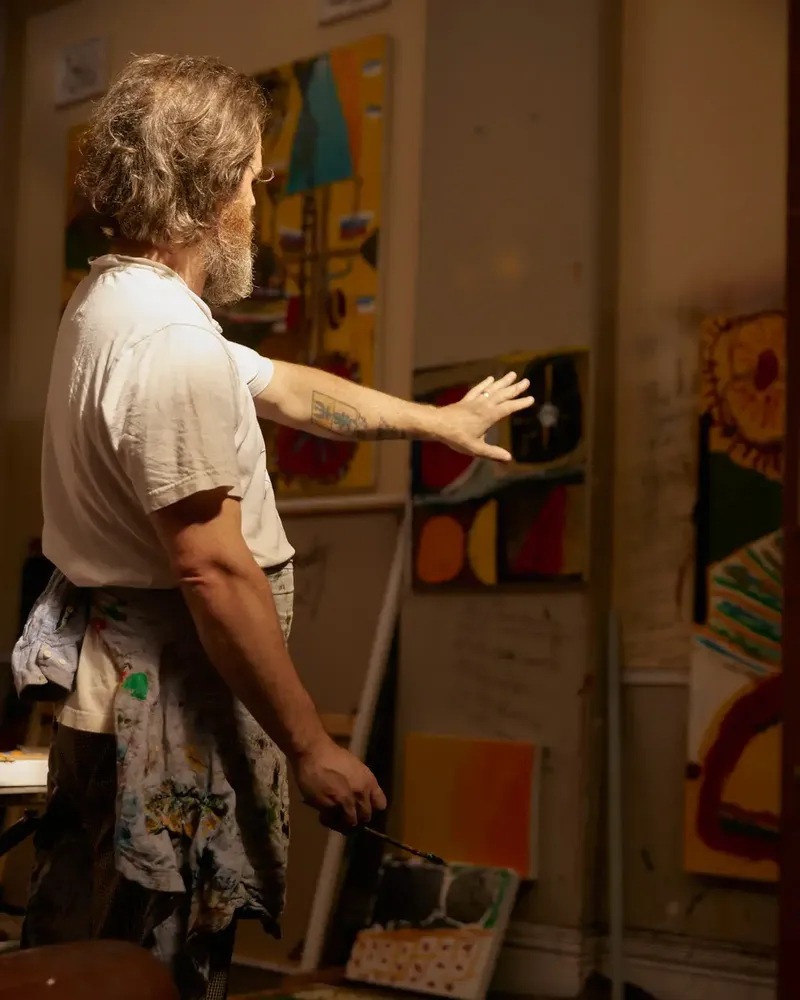

James Drinkwater has featured in ART-CLE Issue 02, 2024:
Known for his raucous yet meticulously composed paintings, James Drinkwater is one of Australia’s most celebrated contemporary artists. Yet, the words ‘contemporary’ and ‘artist’ are not necessarily ones Drinkwater would use to describe himself. He prefers the term ‘painter’, and he is a gestural one at that, drawing on influences from the vast legacy of Australian, British, American and French modern art he became obsessed with as a child growing up in Newcastle, New South Wales. Drinkwater says he started drawing and painting incessantly from the age of five, after becoming taken with the small landscape paintings his aunt would work on at her kitchen table.
Drinkwater’s talent was recognised and nurtured early on, not just by his parents and those around him but also by the art world itself. During our conversation, he fields a call from his dad, who wants to come around and see his recent paintings. “It’s never ideal, the time he wants to come,” Drinkwater says after hanging up. “But I’m never going to say no to that, it’s fuel. You talk about fathers not approving of their kids doing art… artists like Clarice Beckett, you know. My dad was there in the garage with me, standing with a ciggy and a chardonnay just going, ‘Oh, bloody brilliant James. Brilliant. Michelle, come look!’
Between the ages of eight and eighteen, he attended Ron Hartree’s now-closed art school in Newcastle and visited exhibitions whenever his parents could take him. He later attended the National Art School in Sydney—only for one year, before getting restless—and then moved to Melbourne, where he met his now-wife, the painter and performance artist Lottie Consalvo. The pair soon moved to Berlin, where they lived for three years before relocating back to Newcastle in search of cheaper studio space and a quieter life.
In 2014, aged thirty, he won the Brett Whiteley Travelling Art Scholarship, which took his family— then-newly expanded to three with the arrival of his first child, Vincenzo—to the Cité des Arts in Paris for three months and a further three travelling. Fast forward to June 2023, almost a decade on, and a survey exhibition at Canberra’s Drill Hall Gallery—James Drinkwater: at mid-career, curated by Terence Maloon—announced without hesitation Drinkwater’s arrival at that often tenuous artistic milestone.
Drinkwater’s paintings are defined by their expressive use of colour. They are rich in matter, working texture and colour into abstract yet familiar figures, landscapes and interiors that speak of his experiences both real and imagined. In subject, his work draws heavily on the intimacy of his family life, the oceanic environment in which he lives, the broader Australian landscape and the people and places with which he interacts in his movements and travels. As was the case for the 20th century painters Drinkwater has so admired, his own exploration of this personal iconography at once allows insight into his subjective experience and offers something of our shared world to dive into.
- Emma Pegrum, ART-CLE
IMAGE:
James Drinkwater, courtesy Nic Gossage